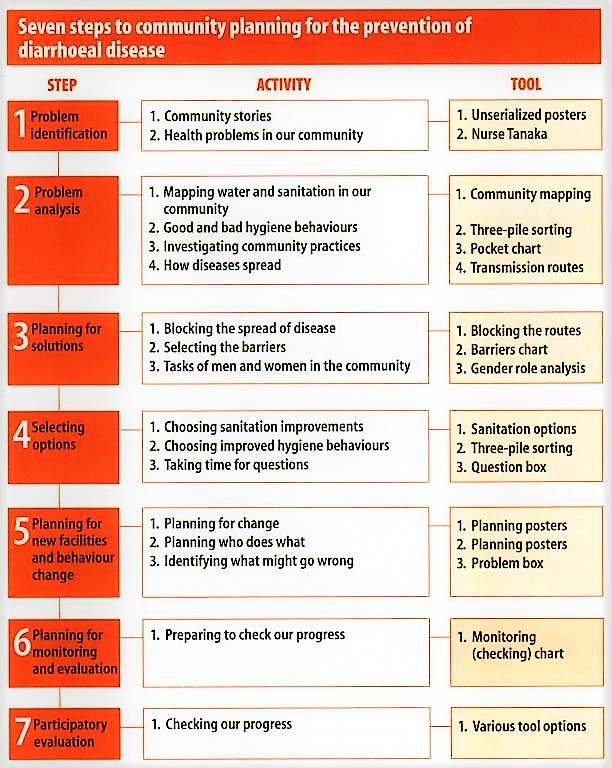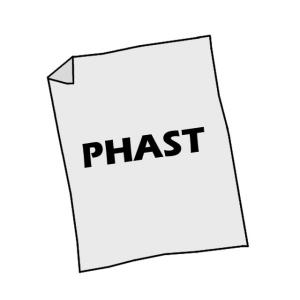Resumen ejecutivo
PHAST stands for “Participatory Hygiene and Sanitation Transformation”. The approach is a participatory learning methodology that seeks to empower communities to improve hygiene behaviours, reduce diarrhoeal disease and encourage effective community management of water and sanitation services (WSSCC 2009). It uses a participatory approach to community learning and planning that follows a seven step framework (NETSSAF 2008). The approach was introduced from the World Health Organisation (WHO).
The Concept of PHAST
PHAST works on the premise that as communities gain awareness of their water, sanitation and hygiene situation through participatory activities, they are empowered to develop and carry out their own plans to improve this situation (WSSCC 2009).
Besides, PHAST seeks to help communities to improve their hygiene behaviours, to prevent diarrhoeal diseases and to encourage community-management of water and sanitation facilities. PHAST hence demonstrates the relationship between sanitation and health status.
Furthermore, the method tries to enhance the self-esteem of the participating community members by involving them into the planning process. Empowering the community helps to plan environmental improvements and to own and to operate water and sanitation facilities. For the achievement of these goals, the PHAST approach is using participatory methods to encourage the participation of individuals in a group process (WHO 1998).
PHAST is based on another participatory methodology called SARAR, which stands for self-esteem, associative strengths, resourcefulness, action-planning and responsibility.
The Seven Step Participatory Approach
PHAST uses a seven-step participatory approach to facilitate a community planning process (see below).
Each step contains between one to four activities a group has to go through to improve their community planning on hygiene and sanitation. These activities shall take place in a participatory manner to enhance the participation of individuals.

In general, the PHAST approach is applicable for all kind of communities who are trying to improve their hygiene and sanitation planning and who want to start a process for community hygiene behaviour change.
Introduction to the NETSSAF Participatory Planning Approach, a tutorial and guideline for sustainable sanitation planning
This presentation describes the NETSSAF participatory planning approach in a brief manner.
BARRETO DILLON, L. BUZIE FRU, C. (2008): Introduction to the NETSSAF Participatory Planning Approach, a tutorial and guideline for sustainable sanitation planning . (= Proceedings of the NETSSAF Final Conference “Pathways towards Sustainable Sanitation in Africa" ). Ouagadougou (Burkina Faso): Network for the development of Sustainable Approaches for large scale implementation of Sanitation in Africa (NETSSAF) URL [Visita: 18.07.2019] PDFPHAST Step-by-Step Guide: A Participatory Approach for the Control of Diarrhoeal Disease
This guide provides a detailed description of the approach and his related core elements. The seven-step approach guides the reader and user through all important aspects of the PHAST planning process. Furthermore, important participatory methods for planning activities are described and training materials are included.
WHO (1998): PHAST Step-by-Step Guide: A Participatory Approach for the Control of Diarrhoeal Disease. Geneva: World Health Organisation WHO URL [Visita: 26.04.2019]Hygiene and Sanitation Promotion
2009 Annual Report
The Water Supply and Sanitation Collaborative Council's mission is to achieve sustainable water supply, sanitation and hygiene for all people in the world. This is the annual report 2009 of WSSCC.
WSSCC (2009): 2009 Annual Report. Geneva: Water Supply & Sanitation Collaborative Council (WSSCC) URL [Visita: 18.06.2019]Somali PHAST Step-by-Step Guide
This guidebook is based on the WHO guidebook and provides the same information in a more compact form. It comes with selected participatory activities for the single planning steps
CARITAS SWITZERLAND/LUXEMBOURG - SWISSGROUP (2007): Somali PHAST Step-by-Step Guide. Geneva: CARITAS SWITZERLAND/LUXEMBOURG - SWISSGROUP URL [Visita: 10.02.2010]The NETSSAF Participatory Planning Approach
This document presents an overview of some existing participatory sanitation planning tools, illustrating the scope of the steps and some of the common methodologies employed in the various frameworks.
NETSSAF (2008): The NETSSAF Participatory Planning Approach. South Africa: Network for the Development of Sustainable Approaches for Large Scale Implementation of Sanitation in Africa. [Accessed: 10.02.2010] PDFProspective Review of PHAST
The review also comments on the status of implementation of PHAST in the eastern and southern Africa region. Furthermore it provides some specific country information of selected African countries and presents concrete lessons learnt.
UNDP & WSP (1998): Prospective Review of PHAST. Nairobi: UNDP-World Bank Regional Water and Sanitation Group East and Southern Africa URL [Visita: 19.06.2019]Hygiene framework
This document sets out WaterAid’s framework for hygiene promotion and behaviour change in the countries where it works. It will also help organisations that work on hygiene in the context of water, sanitation and hygiene (WASH) programmes.
WATERAID (2012): Hygiene framework. London: WaterAid URL [Visita: 19.06.2019]The PHAST Initiative. A New Approach to Working With Communities.
In this document, the PHAST approach is explained from a methodological and historical point of view in a brief and concise manner.
WHO (1997): The PHAST Initiative. A New Approach to Working With Communities.. Geneva: World Health Organisation URL [Visita: 22.04.2012]Hygiene and Sanitation Promotion
Improving nutrition outcomes with better water, sanitation and hygiene: Practical solutions for policy and programmes
This document, jointly prepared by WHO, UNICEF and USAID, summarizes the current evidence on the benefits of WASH for improving nutrition outcomes and describes how WASH interventions can be integrated into national nutrition policies and programmes to add value.
WHO WHO (2015): Improving nutrition outcomes with better water, sanitation and hygiene: Practical solutions for policy and programmes. Geneva: WHO URL [Visita: 24.11.2015]Participatory Hygiene and Sanitation Transformation (PHAST): A methodology for sustainable hygiene and sanitation behaviour change with experience from the Bawku West District of Ghana
Experiences with PHAST in western Ghana.
NUNOO, D., MUMUNI, O and NUKUNU, N. (2009): Participatory Hygiene and Sanitation Transformation (PHAST): A methodology for sustainable hygiene and sanitation behaviour change with experience from the Bawku West District of Ghana. Accra (Ghana): West Africa Regional Sanitation and Hygiene Symposium. URL [Visita: 19.06.2019]Prospective Review of PHAST
The review also comments on the status of implementation of PHAST in the eastern and southern Africa region. Furthermore it provides some specific country information of selected African countries and presents concrete lessons learnt.
UNDP & WSP (1998): Prospective Review of PHAST. Nairobi: UNDP-World Bank Regional Water and Sanitation Group East and Southern Africa URL [Visita: 19.06.2019]Participatory Hygiene and Sanitation Transformation (PHAST) prevent child parasitic enteric infections in Kyrgyz villages
This PowerPoint presentation deals with the connection between hygiene, water supply and an enhancement of the health situation in the Kyrgyz Republic.
WORLD BANK (n.y): Participatory Hygiene and Sanitation Transformation (PHAST) prevent child parasitic enteric infections in Kyrgyz villages. pdf presentation. WORLD BANK. [Accessed: 10.02.2010] PDFEndline Assessment of the Enabling Environment in Peru
A new endline report discusses how Peru’s enabling environment for handwashing with soap has progressed since 2007. The research, conducted by the Water and Sanitation Program (WSP), indicates that the enabling environment has been strengthened at both national and regional levels. In addition, efforts to integrate and institutionalize handwashing with soap behavior change into national, regional, and local policies related to health and nutrition, education, water, and sanitation have largely been achieved.
FAVIN, M. WSP (2011): Endline Assessment of the Enabling Environment in Peru. Washington DC: Water and Sanitation Program (WSP) URL [Visita: 24.10.2011]Behavioral Determinants of Handwashing with Soap Among Mothers and Caretakers: Emergent Learning from Senegal and Peru
A new Water and Sanitation Program (WSP) Learning Note found that beliefs and ease of access to soap and water were correlated with handwashing with soap behaviors for given proxy measures among mothers and caretakers in Peru and Senegal.
WSP (2012): Behavioral Determinants of Handwashing with Soap Among Mothers and Caretakers: Emergent Learning from Senegal and Peru. Washington, D.C: Water and Sanitation Program (WSP) URL [Visita: 27.02.2012]Small Doable Actions: A Feasible Approach to Behavior Change.
A small doable action is a behavior that, when practiced consistently and correctly, will lead to personal and public health improvement. Although the behavior may not be an “ideal practice,” more households likely will adopt it because it is considered feasible within the local context.
USAID USAID (2015): Small Doable Actions: A Feasible Approach to Behavior Change.. Washington : USAID URL [Visita: 25.11.2015]Water sanitation hygiene
This link brings you to the official homepage of the WHO and its water and sanitation department.
Introduction to the NETSSAF participatory planning approach - A tutorial and guideline for sustainable sanitation planning
The NETSSAF tutorial for sustainable sanitation planning introduces a participatory planning approach. It targets planners of sanitation programmes in West Africa and provides guidance in facilitating “informed choices” in consultation with users and other stakeholders.
Annotated Bibliography of 2013 - Handwashing Studies
This annotated bibliography was compiled by WASHplus and contains citations and abstracts to 20 peer-review handwashing studies that were published from January through September 2013. Links are also provided to the abstract or full-text for each article.

